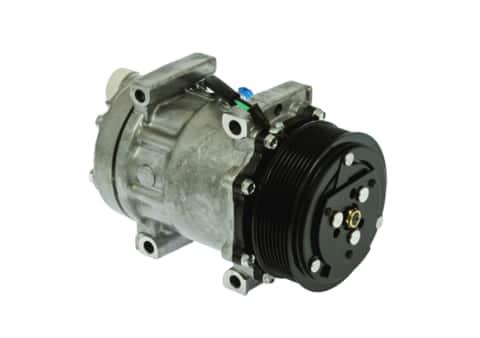A/C Compressors: Built To Last
Revised July, 2023
When it comes to keeping your rig cool and comfortable, a reliable A/C system is crucial. The main part of this system is the A/C compressor. It compresses and circulates refrigerant, cooling the cabin.
It is essential to understand the compressor replacement process. Further, knowing the challenges associated with selecting the right A/C compressor for your truck ensures optimal performance and longevity.

The Compressor Replacement Process
Replacing the A/C compressor involves a series of important steps that should be followed to guarantee a successful installation and optimal performance.
Parts that Need to be Replaced
When replacing the compressor, it is important to replace specific parts. This will help the HVAC system last longer and work more efficiently in provision of cool air.
The parts include the:
- Receiver drier / Accumulator : Opening the a/c system subjects the receiver drier to moisture and contaminants. Moisture can lead to corrosion and damage to the the components. Contaminants can compromise the efficiency of the component. Replacing the receiver drier is essential.
- Expansion valve / Orifice tube : The expansion valve meters refrigerant. Replacing the expansion valve ensures compatibility and avoiding contamination and blockages. Using an old orifice tube or expansion valve risks introducing the new compressor to contaminants.
- A/C hose assemblies with mufflers : The A/C hose assemblies with mufflers ensure a smoother and quieter operation when replaced.
- Condenser : The condenser dissipates heat and compresses refrigerant back into a liquid state to remove it. Some warranties require replacing the condenser with the a/c compressor to prevent exposing the system to contamination and debris. Furthermore, various environmental elements expose the condenser to corrosion or damage. Replacing the condenser ensures compatibility and longevity of your HVAC system.
Flushing is not possible for the condenser. Replacing these components helps maintain the integrity of the system. It also works to prevent potential leaks or contamination.
Flushing Non-Replaced Components
To keep the A/C system clean and efficient, flush non-replaced parts like condensers, evaporators, and hoses properly. Flushing removes debris, contaminants, and any residual oil, prevents clogs, and promotes optimal performance. You MUST flush nonreplaced components until there is no debris or oil (e.g. evaporator, hoses, some condensers, etc.).
Proper Amount & Type of Lubricant

Adding the correct amount and type of lubricant is crucial for the A/C compressor’s smooth operation. The lubricant helps reduce friction, prevent wear and tear, and prolong the compressor’s lifespan. Check the manufacturer's instructions to find the right lubricant and amount for your A/C system.
System Charged with Right Amount of Refrigerant
After completing all necessary replacements, flushing, and lubrication, you must fill the A/C system with the appropriate amount of refrigerant. This step requires careful execution. Incorrect charging of the system can lead to cooling issues and damage the compressor. Conduct a leak test to ensure that you properly seal the system before charging.
Keep Your Cool with FleetPride
For a smooth journey, remember to change parts, clean non-replaced ones, use the correct oil, and charge the system properly. Ask your supplier or check the manufacturer's recommendations to know what your semi truck's A/C system needs.
For reliable A/C compressors and expert advice, visit FleetPride.com. Our wide range of products and Heavy Duty Experts™ can help you select the correct A/C compressor for your truck. Why compromise on comfort and reliability? Visit FleetPride.com today!
* The forgoing is provided for informational purposes only. Please consult your local FleetPride Heavy Duty Experts to verify the suitability of a part for the intended application.

